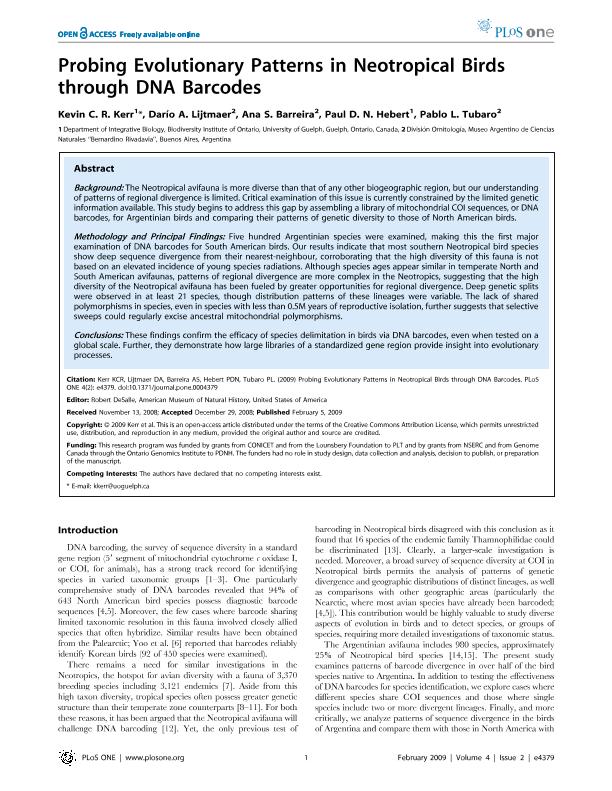Mostrar el registro sencillo del ítem
dc.contributor.author
Kerr, Kevin C. R.
dc.contributor.author
Lijtmaer, Dario Alejandro

dc.contributor.author
Barreira, Ana Soledad

dc.contributor.author
Hebert, Paul David Neil

dc.contributor.author
Tubaro, Pablo Luis

dc.date.available
2020-04-27T20:57:40Z
dc.date.issued
2009-02
dc.identifier.citation
Kerr, Kevin C. R.; Lijtmaer, Dario Alejandro; Barreira, Ana Soledad; Hebert, Paul David Neil; Tubaro, Pablo Luis; Probing Evolutionary Patterns in Neotropical Birds through DNA Barcodes; Public Library of Science; Plos One; 4; 2; 2-2009; 1-6
dc.identifier.issn
1932-6203
dc.identifier.uri
http://hdl.handle.net/11336/103727
dc.description.abstract
Background: The Neotropical avifauna is more diverse than that of any other biogeographic region, but our understanding of patterns of regional divergence is limited. Critical examination of this issue is currently constrained by the limited genetic information available. This study begins to address this gap by assembling a library of mitochondrial COI sequences, or DNA barcodes, for Argentinian birds and comparing their patterns of genetic diversity to those of North American birds. Methodology and Principal Findings: Five hundred Argentinian species were examined, making this the first major examination of DNA barcodes for South American birds. Our results indicate that most southern Neotropical bird species show deep sequence divergence from their nearest-neighbour, corroborating that the high diversity of this fauna is not based on an elevated incidence of young species radiations. Although species ages appear similar in temperate North and South American avifaunas, patterns of regional divergence are more complex in the Neotropics, suggesting that the high diversity of the Neotropical avifauna has been fueled by greater opportunities for regional divergence. Deep genetic splits were observed in at least 21 species, though distribution patterns of these lineages were variable. The lack of shared polymorphisms in species, even in species with less than 0.5M years of reproductive isolation, further suggests that selective sweeps could regularly excise ancestral mitochondrial polymorphisms. Conclusions: These findings confirm the efficacy of species delimitation in birds via DNA barcodes, even when tested on a global scale. Further, they demonstrate how large libraries of a standardized gene region provide insight into evolutionary processes.
dc.format
application/pdf
dc.language.iso
eng
dc.publisher
Public Library of Science

dc.rights
info:eu-repo/semantics/openAccess
dc.rights.uri
https://creativecommons.org/licenses/by/2.5/ar/
dc.subject
Argentina
dc.subject
Birds
dc.subject
DNA barcodes
dc.subject
Evolutionary patterns
dc.subject
Neotropics
dc.subject.classification
Zoología, Ornitología, Entomología, Etología

dc.subject.classification
Ciencias Biológicas

dc.subject.classification
CIENCIAS NATURALES Y EXACTAS

dc.title
Probing Evolutionary Patterns in Neotropical Birds through DNA Barcodes
dc.type
info:eu-repo/semantics/article
dc.type
info:ar-repo/semantics/artículo
dc.type
info:eu-repo/semantics/publishedVersion
dc.date.updated
2020-04-22T14:41:23Z
dc.journal.volume
4
dc.journal.number
2
dc.journal.pagination
1-6
dc.journal.pais
Estados Unidos

dc.journal.ciudad
San Francisco
dc.description.fil
Fil: Kerr, Kevin C. R.. University of Guelph; Canadá
dc.description.fil
Fil: Lijtmaer, Dario Alejandro. Consejo Nacional de Investigaciones Científicas y Técnicas. Oficina de Coordinación Administrativa Parque Centenario. Museo Argentino de Ciencias Naturales "Bernardino Rivadavia"; Argentina
dc.description.fil
Fil: Barreira, Ana Soledad. Consejo Nacional de Investigaciones Científicas y Técnicas. Oficina de Coordinación Administrativa Parque Centenario. Museo Argentino de Ciencias Naturales "Bernardino Rivadavia"; Argentina
dc.description.fil
Fil: Hebert, Paul David Neil. University of Guelph; Canadá
dc.description.fil
Fil: Tubaro, Pablo Luis. Consejo Nacional de Investigaciones Científicas y Técnicas. Oficina de Coordinación Administrativa Parque Centenario. Museo Argentino de Ciencias Naturales "Bernardino Rivadavia"; Argentina
dc.journal.title
Plos One

dc.relation.alternativeid
info:eu-repo/semantics/altIdentifier/url/http://www.plosone.org/article/info%3Adoi%2F10.1371%2Fjournal.pone.0004379
dc.relation.alternativeid
info:eu-repo/semantics/altIdentifier/doi/http://dx.doi.org/10.1371/journal.pone.0004379
Archivos asociados
